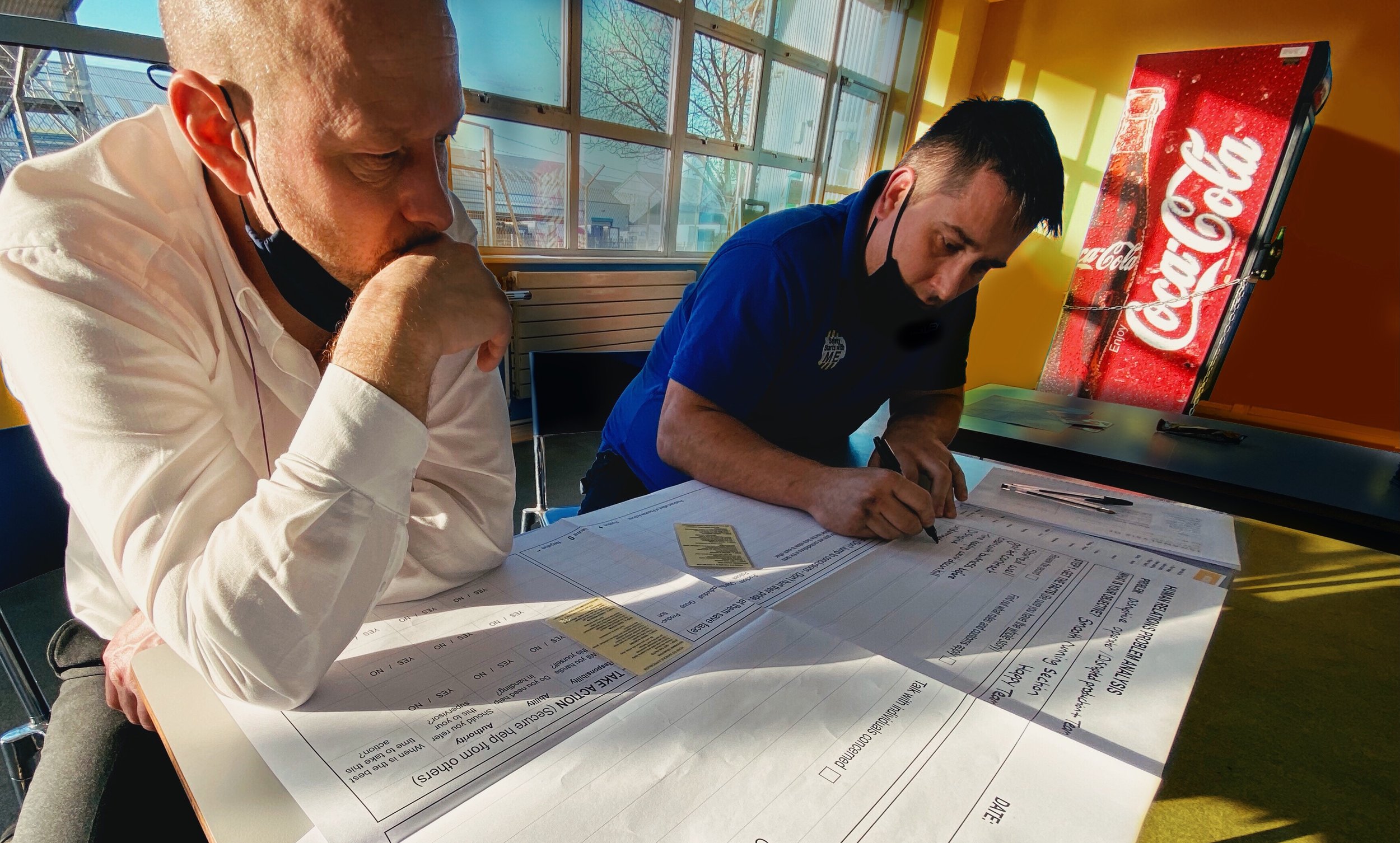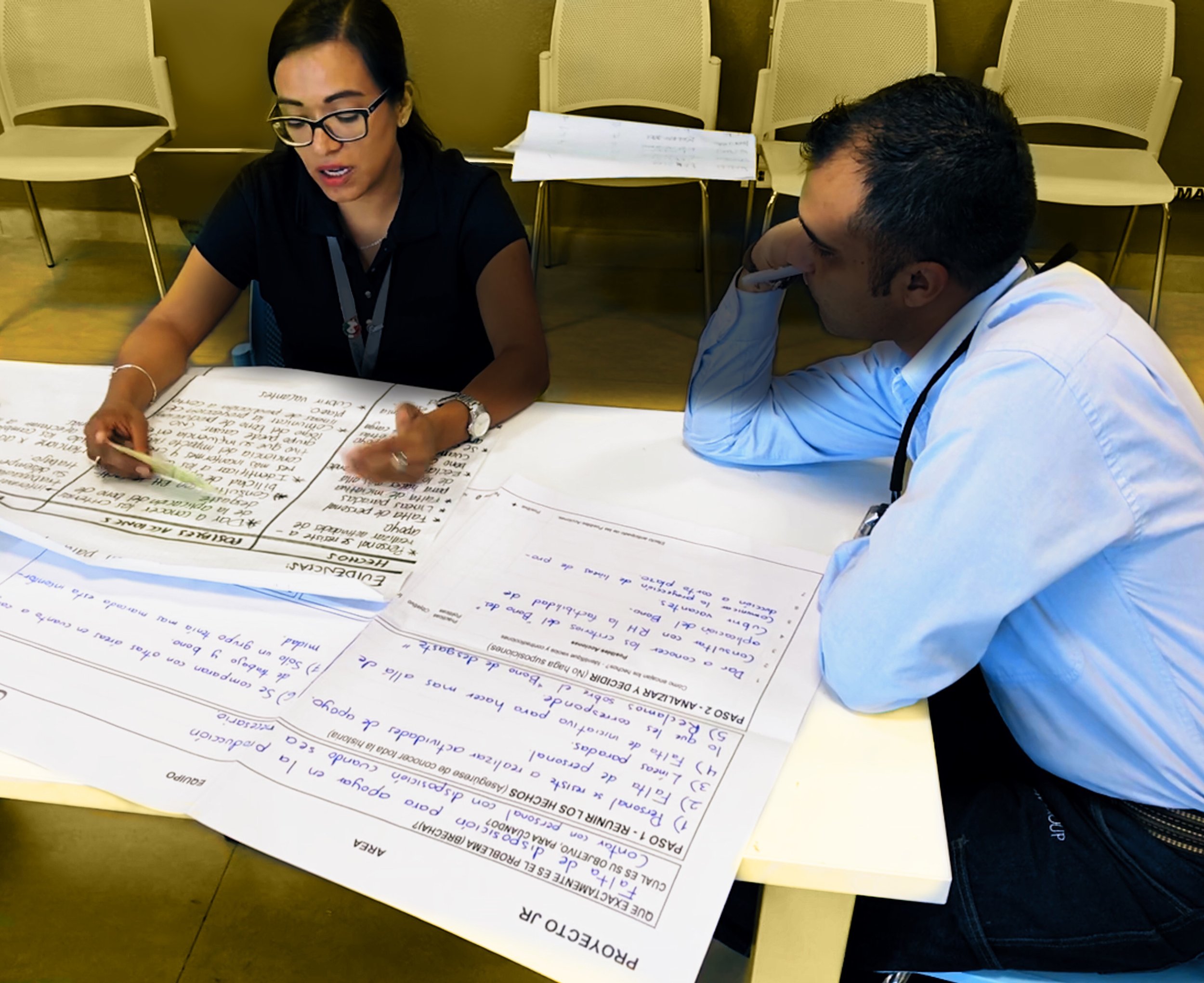
TWI JOB RELATIONS. TWI JR.
-
Impact
Engagement: unlock the potential of each team member by building cooperation and trust
Employee retention: reduce staff turnover by enabling everyone to reach their potential
Reduce absenteeism: by challenging and supporting people and building strong relationships
Performance: a motivated, cohesive team performs better and goes the extra mile
-
How it works
Everyday relations: TWI JR develops small daily habits that grow, support and motivate team members and strengthen relationships and trust.
Problem awareness: TWI Job Relations develops the ability to anticipate and see problems. Problems are not left to fester, but are reliably handled before they grow.
Problem-solving skill: TWI JR develops skill in handling people problems. Supervisors learn to correctly assess problem situations and take appropriate actions.
-
Core elements
TWI JR 4-Step Method: a problem solving pattern that improves attitudes & behaviours and strengthens relationships
TWI JR Foundations: daily habits that prevent problems by m motivating, coaching and growing people
Problem escalation staircase: a framework that enables supervisors to anticipate and detect problems when they are small and easy to handle
Why TWI Job Relations?
Results through people
When people get promoted to supervisor, they quickly need to learn new ways of fulfilling their responsibilities. Being good at the technical aspects of their job and working hard is no longer enough for success.
Supervisors get results through people. To be successful, supervisors therefore need to develop leadership skills in working with people, developing them and building strong relationships of trust and cooperation.
TWI Job Relations develops the Skill in Leading: how to prevent people problems through small, daily interventions, how to spot any people problems early before they escalate and how to handle people problems quickly and effectively.
Prevent people problems
Supervisors’ ability to fulfil their responsibilities depends on their ability to obtain the trust and cooperation of their people. In TWI JR we say, a supervisor must keep the Job Relations Line connecting her with her people straight and strong. Poor job relations give poor results and good job relations give good results.
Through TWI Job Relations training, participants learn how to use the Four Foundations for Good Job Relations which - if practised daily - prevent many people-problems from arising. The TWI JR Foundations involve frequent feedback and coaching, giving praise and encouragement, preparing and guiding their team through changes and developing individuals so they can reach their full potential.
Handle problems early
Not all people-problems can be prevented. Supervisors need to detect problems early and handle them quickly and fairly, so that the Job Relations Line can be straightened out again and performance impact kept to a minimum.
The TWI JR 4-Step Method develops supervisors’ skill in handling people problems. By carefully considering all the circumstances of the problem and the perspective of the people involved when taking decisions, as well as the policies of their organisation, supervisors avoid jumping to conclusions and taking inappropriate actions. Supervisor also develop the habit of carefully preparing and timing their actions, securing needed support and following-up diligently on their actions to ensure the best results.
Leaders have followers. To be a good supervisor means…
to get your people to do what needs to be done, when it needs to be done, in the way it needs to be done because they want to do it..
Three tools of TWI Job Relations
TWI JR is a foundational leadership skill that enables supervisors to motivate and build trust and cooperation with their people. It consists of three core elements: Four Foundations for Good Job Relations, TWI JR Problem Escalation Staircase, and TWI JR 4-Step Method.
TWI JR Foundations
The TWI JR Four Foundations for Good Job Relations provide clear guidance on how to keep the Job Relations line straight and strong:
Let each person know how they are performing: highlight exactly what needs to be improved and coach how to improve it
Give credit when due: express appreciation for people’s effort and contributions to motivate and reinforce desired behaviours.
Tell people in advance about changes: thoughtfully guide them through changes to smooth the transition and prevent problems
Make best use of each person’s ability: fully utilise and develop each person’s capability to unleash energy, creativity and engagement
By making the Four Foundations a daily habit, supervisors can prevent many people problems.
Problem escalation staircase
Not all people problems can be prevented. Supervisors need to learn how spot problems early, before they escalate.
TWI JR identifies four stages of problem escalation.
Size up a problem before it happens: anticipate problems to take preventive action.
Being tipped off: pay attention to subtle changes in attitudes, behaviours & relationships, to get into problems before they escalate.
Coming to you: if someone makes you aware of a problem, it usually means it has been going on for a while, has grown and affects other people.
Running into: A person refuses to follow instructions or a rule or there is open conflict. At this stage of escalation, problems tend to be much harder to handle.
TWI JR 4-Step Method
Problems rarely go away on their own and tend to grow if not handled quickly, correctly and fairly. The TWI Job Relations 4-Step Method develops this essential supervisor skill. Supervisors learn how to consider the whole story by obtaining all the facts related to the problem, including opinions and feelings. This protects them from jumping to conclusions and taking the wrong action.
Once obtained, the facts are then carefully weighed and a range of possible actions is developed. The supervisor assesses the likely impact of each of the actions to determine which action to take and how best to go about it. Timing and preparation are critical for success, as is obtaining any support and authorisation needed. The supervisor then proceeds to executing her plan and carefully monitors any changes in attitudes, behaviours, relationships and performance.
People must be treated as individuals. …
People are all different and constantly change. Strictly speaking, the same person who left work yesterday is different from the person who comes through the door today.
TWI JR 4-Step Method
Good leadership is a skill that can be easily acquired by repeating a time-proven pattern. The TWI Job Relations 4-Step Method enables supervisors to handle people problems quickly, correctly and fairly. By using it, supervisors ensure their team members are highly motivated and relationships are strong and productive.
STEP 1 - Get the facts
Good problem solving relies on how well the supervisor knows the people involved and understands what is really going on. Considering only a few facts may easily lead to inappropriate action.
The supervisor must therefore ensure she assembles the whole story. Relevant facts include what is known about the people involved and how the situation relates to rules and customs of the organisation.
Equally important is obtaining the opinions and feelings of the individuals involved, which are considered alongside the other facts.
STEP 2 - Weigh and decide
The supervisor considers carefully how the facts relate to each other. Are there any gaps or contradictions? Are any additional facts needed before proceeding?
Based on the facts she develops a range of possible actions, ensuring they are in line with company policy.
By predicting the impact of the proposed actions on her objective, the individual, the team and performance the supervisor selects and fine-tunes the most appropriate actions.
STEP 3 - Take action
The supervisor further refines her actions to ensure the best results. Now that she has decided what she will do, she asks exactly how best to do it.
She considers her ability to take the planned actions and what support she might require. She also considers her authority to take the actions and whether she needs to obtain approvals or get support from her manager.
With this preparation in place, the final consideration is about timing of the proposed actions. The right action at the wrong time might turn out to be less effective or even cause harm.
STEP 4 - Check results
The supervisor carefully plans how she will check the impact of her actions. How soon can she expect a change? How often and for how long will she need to follow up to ensure the actions have the desired effect?
She stays in touch with the situation and watches for changes in attitudes, behaviours, relationships and performance. Small corrections might be necessary and observing closely ensures that she is ‘tipped off’ early.
Once the problem is resolved, she continues her regular application of the the TWI JR 4 Foundations.


